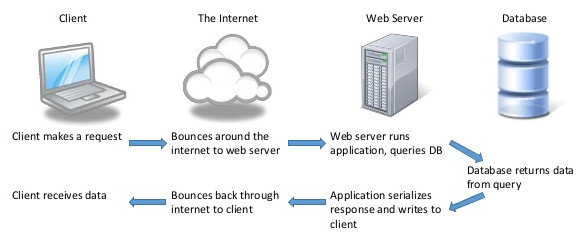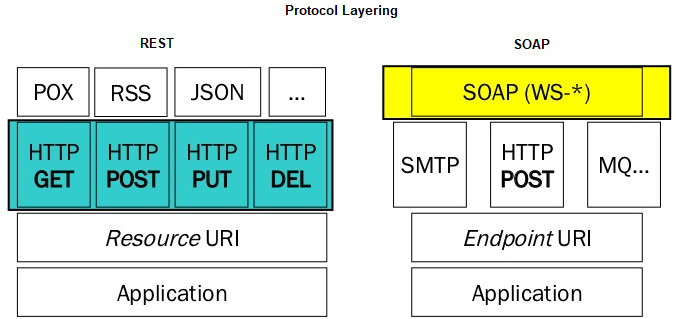
Web services are XML-based information exchange systems that use the Internet for direct application-to-application interaction. These systems can include programs, objects, messages, or documents. Web services are defined to actively fetch, read, or transfer data from a defined source to produce a specified outcome – a result.
Below diagram shows simple Application Programming Interface (API) flow.

Simple Object Access Protocol (SOAP) and Representational State Transfer (REST) are two ways to access Web services.
Both SOAP and REST share similarities over the HTTP protocol, SOAP is a more rigid set of messaging patterns than REST. The rules in SOAP are important because without these rules, you can’t achieve any level of standardization. REST as an architecture style does not require processing and is naturally more flexible. Both SOAP and REST rely on well-established rules that everyone has agreed to abide by in the interest of exchanging information.

Key Differences between SOAP and REST are as below.
SOAP is a protocol, whereas REST is an architectural style
An API is designed to expose certain aspects of an application’s business logic on a server, and SOAP uses a service interface to do this while REST uses URIs.
REST APIs access a resource for data (a URI), whereas SOAP APIs perform an operation
REST is an architecture which is more data-driven, whereas SOAP is a standardized protocol for transferring structured information that’s more function-driven.
+
REST permits many different data formats
REST permits many different data formats including plain text, HTML, XML, and JSON, which is a great fit for data and yields more browser compatibility, whereas SOAP only uses XML.
Security is handled differently - SOAP supports WS-Security
Security is handled differently - SOAP supports WS-Security, which is great at the transport level and a bit more comprehensive than SSL, and more ideal for integration with enterprise-level security tools. Both support SSL for end-to-end security, and REST can use the secure version of the HTTP protocol, HTTPS.
SOAP requires more bandwidth whereas REST requires fewer resources
SOAP requires more bandwidth whereas REST requires fewer resources (depending on the API). There’s a little more overhead with SOAP out of the gate, on account of the envelope-style of payload transport. Because REST is used primarily for web services, its being lightweight is an advantage in those scenarios.
REST calls can be cached, SOAP-based calls cannot be cached
Data can be marked as cacheable, which means it can be reused by the browser later without having to initiate another request back to the server. This saves time and resources.
SOAP is tightly coupled with the server whereas REST is coupled to a lesser degree
SOAP is very closely coupled with the server, having a strict communication contract with it that makes it more difficult to make changes or updates. A client interacting with a REST API needs no knowledge of the API, but a client interacting with a SOAP API needs knowledge about everything it will be using before it can even initiate an interaction.
To know more about our services, email us at shekhar.pawar@grassdew.com